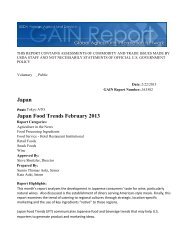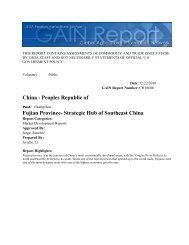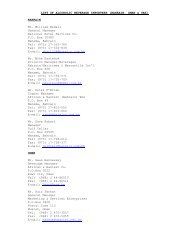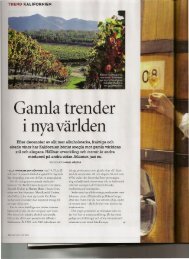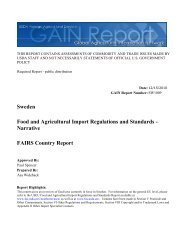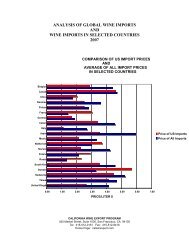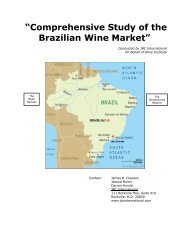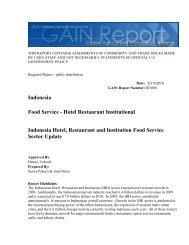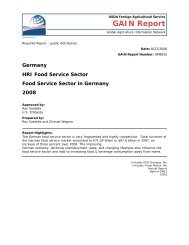FAIRS Country Report Food and Agricultural Import ... - GAIN
FAIRS Country Report Food and Agricultural Import ... - GAIN
FAIRS Country Report Food and Agricultural Import ... - GAIN
You also want an ePaper? Increase the reach of your titles
YUMPU automatically turns print PDFs into web optimized ePapers that Google loves.
flavoring is regulated by Regulation (EC) No 1331/2008.Following regulations are related:Regulation (EC) No 1331/2008 authorization procedures for food additives, enzymes <strong>and</strong> flavorings,Regulation (EC) No 1332/2008 on food enzymes, Regulation (EC) No 1334/2008 on food flavorings.This material can be accessed on line athttp://europa.eu/legislation_summaries/consumers/product_labelling_<strong>and</strong>_packaging/sa0003_en.htm.New Regulations recently approved by EU: Commission Directive 2011/3/EU of 17 January 2011amended Directive 2008/128/EC <strong>and</strong> laid down specific purity criteria on colors for use in foodstuffs(L13, 18.1.2011, page 59).Commission Directive 2010/69/EU of 22 October 2010 amended the Annexes to European Parliament<strong>and</strong> Council Directive 95/2/EC on food additives other than colors <strong>and</strong> sweeteners (OJ L279,23.10.2010, page 22).Commission Directive 2010/67/EU of 20 October 2010 amended Directive 2008/84/EC which laiddown specific purity criteria on food additives other than colors <strong>and</strong> sweeteners (OJ L277, 21.10.2010,page 17).Following agents such as chlorine, bromates, <strong>and</strong> peroxides are not permitted for use in foods in EUfood preparations.Section V. Pesticides <strong>and</strong> Other Contaminants:Lithuania adapted EU Council Regulation related to the presence of pesticide <strong>and</strong> other contaminants infood <strong>and</strong> foodstuffs. European Parliament <strong>and</strong> Council Regulation 1107/2009 set out new rules for theauthorization of plant protection products (PPPs) <strong>and</strong> replaces Directive 91/414/EEC. It entered intoforce at the end of December 2009 <strong>and</strong> became fully applicable on June 14, 2011. This Regulationestablishes a list of approved active substances. Only PPPs containing active substances included in thelist may be authorized for use in the EU. Member States can approve PPPs containing the activesubstances. According to the new Regulation, the EU is divided in three different zones. Once aMember State approves the PPP it can be mutually recognized <strong>and</strong> thus authorized within the same EUzone as set out in Annex I of the Regulation.EU implemented special import conditions on testing almonds supplied to the EU Member States.Commission Regulations 1152/2009 imposes special regulations for importing of almonds to EU fromthird countries due to the aflatoxin contamination.Commission Regulation (EU) No 178/2010 of 2 March 2010 amended Regulation (EC) No 401/2006relates to groundnuts (peanuts), other oilseeds, tree nuts, apricot kernels, liquorices <strong>and</strong> vegetable oil(OJ L52, 3.3.2010, page 32) [Sampling procedures for contaminants]Commission Regulation (EU) No 165/2010 of 26 February 2010 amended Regulation (EC) No1881/2006 sets maximum levels for certain contaminants in foodstuffs with regards to aflatoxins (OJL50, 27.2.2010, page 8).



